LAB REPORT
Science and Technology Making Headlines
Feb. 25, 2022

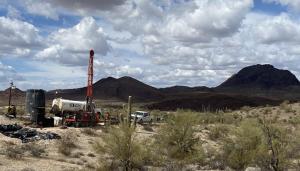
La Paz Scandium and Rare Earth Project located in La Paz County, Arizona. Image courtesy of Western Rare Earths.
In rare form
LLNL researchers and collaborators are trying to crack the problem of extracting rare earth elements (REE) from waste.
REEs, a group of 17 elements, are critical ingredients for technologies that make our world run: smartphones, EV motors and wind turbines. But extracting them from the earth is dirty business, causing environmental damage and tons of waste, including low-level radioactive waste.
Then there are global supply chain issues. Contrary to their name, rare earths are actually not that rare in Earth’s crust. China, however, has cornered the lion’s share of the market, mining more than 70 percent of the world’s REEs and processing an even greater percentage.
A team from Lawrence Livermore and Penn State are working with Western Rare Earths to develop a process that uses a recently discovered natural protein to extract rare earths. And the U.S. Department of Energy announced that it plans to build the first large-scale facility to extract REEs and other critical metals from mine waste.

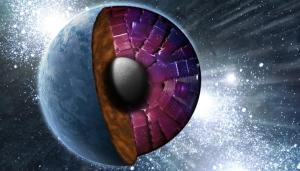
An artist’s conception of the cross section of a super-Earth with the NIF target chamber superimposed over the mantle, looking into the core. Image by John Jett/LLNL.
Ironing it out
“Super-Earths” keep popping up. The most numerous exoplanets are those between Earth and Neptune in size, yet they also are the most perplexing. Are they rocky like Earth, complete with atmospheres and liquid water, but much larger? Or are they “mini-Neptunes” with a variable gas envelope and unlivable temperatures and pressures? In the hunt for life, it’s a crucial difference. The high pressures and thermal conditions on exoplanets with masses several times that of Earth are unknown.
So why not discover more about “super-Earths” by using one of the world’s most powerful lasers?
Richard Kraus from the Lawrence Livermore National Laboratory and his colleagues began their research with the knowledge that Earth, the only known habitable planet in the cosmos, has a magnetic field. It shields life from the dangers of charged particles carried by the sun’s wind. Scientists were able to calculate the melting temperature of iron by using very high-energy lasers at LLNL’s National Ignition Facility to replicate the same heat assumed to be present in “super-Earth” cores.

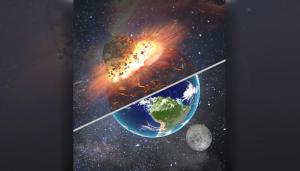
Evidence from the analysis of lunar samples suggest that although the Earth and moon formed from a giant impact, they mostly retained their primordial abundances of volatile elements, including water. Image by Adam Connell/LLNL.
Many moons ago
Fresh analysis of rocks collected from the moon may have allowed scientists to come up with a new theory explaining the source of Earth’s water – the origin of life as we know it.
Scientists of Lawrence Livermore National Laboratory, weighing in on the longstanding debate, have concluded that the likeliest explanation is that Earth was formed with its water.
The study appears to reject the commonly accepted notion that one potential way the water was delivered was by bombardment from water-bearing asteroids and comets.
"Earth was either born with the water we have, or we were hit by something that was basically pure H2O, with not much else in it," explained cosmochemist Greg Brennecka of LLNL. "This work eliminates meteorites or asteroids as possible sources of water on Earth and points strongly toward the 'born with it' option."

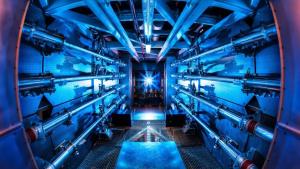
The fusion reactions at the National Ignition Facility take place at the heart of the world’s most powerful laser system.
Light my fire
The secret behind a record-breaking nuclear fusion experiment that spit out 10 quadrillion watts of power in a split second has been revealed: a "self-heating" — or "burning" — plasma of neutron-heavy hydrogen inside the fuel capsule used in the experiment, according to researchers.
Last year, scientists at the Lawrence Livermore National Laboratory announced the record release of 1.3 megajoules of energy for 100 trillionths of a second at the National Ignition Facility (NIF). In two new research papers, NIF scientists show the achievement was due to the precision engineering of the tiny cavity and fuel capsule at the heart of the world's most powerful laser system, where the fusion took place.
Although the fuel capsule was only about a millimeter (0.04 inch) across, and the fusion reaction lasted only the briefest sliver of time, its output was equal to about 10 percent of all the energy from sunlight that hits Earth every instant.
The researchers said the reaction blasted out that much energy because the process of fusion itself heated the remaining fuel into a plasma hot enough to enable further fusion reactions.

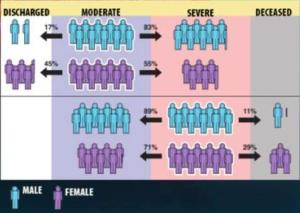
Being male is a known risk factor for adverse outcomes in hospitalized COVID-19 patients. However, new analysis reveals that when modeling the entire disease trajectory, the degree to which being male is a risk factor depends on the underlying disease severity of the patient. Image by Priyadip Ray/LLNL.
Modeling COVID-19 risk factors
A Lawrence Livermore team has developed a comprehensive dynamic model of COVID-19 disease progression in hospitalized patients, finding that risk factors for complications from the disease are dependent on the patient’s disease state.
Using a machine learning algorithm on a dataset of electronic health records from more than 1,300 hospitalized COVID-19 patients with ProMedica — the largest health care system in northwestern Ohio and southeastern Michigan — the team classified patients into “moderate” or “severe” states and tracked disease trajectory as patients moved through different risk states during hospitalization.
Accounting for disease severity — in contrast to previous scientific literature examining only static risk factors — the method allowed the team to identify, as the disease progressed, when certain variables such as age and race, and comorbidities including diabetes and hypertension, led to more severe outcomes.





